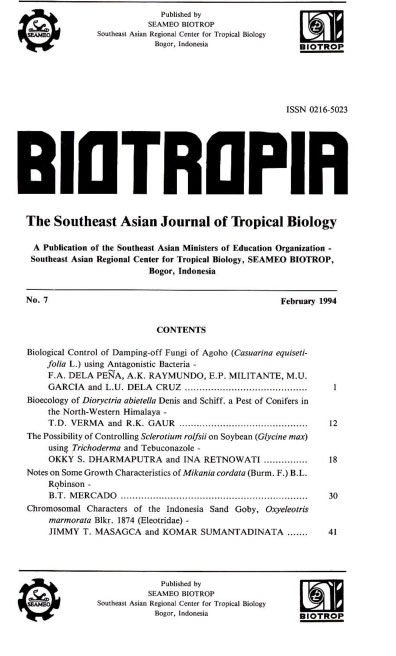
Tags
BIOLOGICAL CONTROL OF DAMPING-OFF FUNGI OF AGOHO (CASUARINA EQUISETIFOLIA L.) USING ANTAGONISTIC BACTERIA
Content Language : English

A series of laboratory and nursery experiments were conducted specifically to determine the efficacy of 85
strains of Bacillus species and 15 actinomycetes against six fungal pathogens isolated from damped-off agoho.
These damping-off fungi were: Fusarium oxysporum Schet., Rhizoctonia solani Kuhn., Phytophthora parasitica
Dastur, Pythium debaryanum Hesse, and two unidentified pathogens temporarily designated as Unk 1 and Unk 2.
Preliminary test using the agar-plug technique revealed that 18 of the bacterial isolates could suppress two or
more of the six damping-off fungi. Fusarium oxysporum was inhibited by 17 bacterial isolates, R. solani by 8
isolates, P. parasitica by 14 isolates and P. debaryanum by 15 isolates. The unidentified damping-off fungi Unk
1 and Unk 2 were inhibited by 13 and 9 isolates, respectively.
Further screening using the agar-diffusion method disclosed that 10 isolates were effective antagonists with
Bacillus subtilis (Code No. R060), Bacillus sp. (Code No. R071), and Streptomyces sp. (Code No. R086) as the
consistent and most effective inhibitors.
Application of the three most promising antagonistic bacteria as seed treatment s howed that they
effectively inhibited the growth of the damping-off fungi in the laboratory as exhibited by an increase in percent
germination. Bacillus subtilis however, was not able to antagonize the effect of P. debaryanum in this particular
experiment.
Seed germination and seedling survival were likewise improved with the application of the three most
promising antagonistic bacteria as seed treatment. This was shown after three months under nursery conditions.
There were possible mechanisms of control by the antagonistic bacteria against the damping-off fungi. The
mycelium and spores of the pathogenic fungus may have been attacked and parasitized by the antagonist when
they were simultaneously grown in culture media. There must have been a competitive interaction between the two
microorganisms. Any essential requirement of microorganisms can serve as potentially possible basis for
competition.
Another was antibiosis which is an inhibitory effect exerted by an organism upon another organism through
the production of antibiotic compounds. Moreover, several strains of bacteria are effective in lysing cell walls of
pathogenic fungi under laboratory conditions. Lysis is often attributed to production of cell wall degrading
enzymes like chitinase and gluconase that may hydrolyze major constituents of fungal cell walls.
Link

This work is licensed under a Creative Commons Attribution-NonCommercial-NoDerivatives 4.0 International License.
